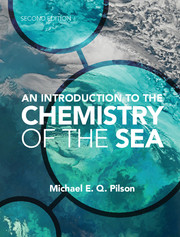Book contents
- Frontmatter
- Contents
- Preface
- Acknowledgments
- 1 Introduction
- 2 The water in seawater
- 3 Salinity, chlorinity, conductivity, and density
- 4 Major constituents of seawater
- 5 Simple gases
- 6 Salts in solution
- 7 Carbon dioxide
- 8 Nutrients
- 9 Trace metals and other minor elements
- 10 Radioactive clocks
- 11 Organic matter in the sea
- 12 Anoxic marine environments
- 13 Exchanges at the boundaries
- 14 Chemical extraction of useful substances from the sea
- 15 Geochemical history of the oceans
- Appendix A The chemical elements
- Appendix B Symbols, units, and nomenclature
- Appendix C Physical properties of seawater
- Appendix D Gases
- Appendix E Carbon dioxide
- Appendix F Dissociation constants and pH scales
- Appendix G Solubility of calcium carbonate
- Appendix H Effects of pressure
- Appendix I Radioactive decay
- Appendix J Geochemical reservoirs, and some rates
- Appendix K Sound absorption
- Epilogue
- Questions for chapters
- Glossary
- References
- Index
- Miscellaneous end matter
Appendix I - Radioactive decay
Published online by Cambridge University Press: 05 February 2013
- Frontmatter
- Contents
- Preface
- Acknowledgments
- 1 Introduction
- 2 The water in seawater
- 3 Salinity, chlorinity, conductivity, and density
- 4 Major constituents of seawater
- 5 Simple gases
- 6 Salts in solution
- 7 Carbon dioxide
- 8 Nutrients
- 9 Trace metals and other minor elements
- 10 Radioactive clocks
- 11 Organic matter in the sea
- 12 Anoxic marine environments
- 13 Exchanges at the boundaries
- 14 Chemical extraction of useful substances from the sea
- 15 Geochemical history of the oceans
- Appendix A The chemical elements
- Appendix B Symbols, units, and nomenclature
- Appendix C Physical properties of seawater
- Appendix D Gases
- Appendix E Carbon dioxide
- Appendix F Dissociation constants and pH scales
- Appendix G Solubility of calcium carbonate
- Appendix H Effects of pressure
- Appendix I Radioactive decay
- Appendix J Geochemical reservoirs, and some rates
- Appendix K Sound absorption
- Epilogue
- Questions for chapters
- Glossary
- References
- Index
- Miscellaneous end matter
Summary
As in many fields, the units and their definitions have changed with time. Originally, the primary unit was selected to be the amount of radiation produced by 1 gram of radium, and it was named the “curie,” after Marie Sklodowska Curie. A remarkable scientist, she is the only woman to have won two Nobel prizes, and the only person to have won two Nobel prizes in different fields of science. The first was the physics prize (1903), shared with Henrie Becquerel who had discovered radioactivity, and with her husband and co-worker, Pierre Curie, for discovering polonium and radium. The second was the chemistry prize (1911), for her work with the properties of radium.
The original definition of the curie was unsuitable for several reasons; notably there are three isotopes of radium, with different properties, and the measurements are difficult to make. The curie is still in general use because of its history and familiarity, but it is now defined as being equal to 3.7 × 1010 Bq.
Table I.1 lists the common units used to express the amount of radioactivity and to express the energy carried by various particles and X-ray and g-ray photons. The evaluation of biological effects of radiation is complex, and some special units that are used for this purpose are also listed
- Type
- Chapter
- Information
- An Introduction to the Chemistry of the Sea , pp. 456 - 458Publisher: Cambridge University PressPrint publication year: 2012



